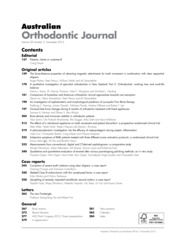Measurements from conventional, digital and CT-derived cephalograms: a comparative study
-
Eser Sahibi
ASLI BAYSAL
-
Tür
Makale
- Yayın Tarihi 2012
-
Yayıncı
Australian Society of Orthodontists
- Dergi Adı Australian Orthodontic Journal 28, ( 2 ), pp.232 - 239
- Tek Biçim Adres Http://hdl.handle.net/11469/171
- Konu Başlıkları Cephalograms
Objective: The purpose of this retrospective radiographic study was to determine the reliability and reproducibility of skeletal and
dental measurements of lateral cephalograms created from a computerised tomography (CT) scan compared with conventional
and digital lateral cephalograms.
Methods: CT and conventional lateral cephalograms of the same patients were obtained from university archives. The lateral
cephalometric radiographs of 30 patients were manually traced. The radiographs were subsequently scanned and traced using
Dolphin Imaging software version 11 (Dolphin Imaging, Chatsworth, CA, USA). The CT-created lateral cephalograms were also
traced using the same software. Sixteen (10 angular and 6 linear) measurements were performed. Cephalometric measurements
obtained from conventional, digital and CT-created cephalograms were statistically compared using repeated measures analysis
of variance (ANOVA). Statistical significance was set at the p < 0.05 level of confidence.
Results: The intra-rater reliability test for each method showed high values (r > 0.90) except for mandibular length which had a
correlation of 0.82 for the CT-created cephalogram. Five measurements (N-A-Pog, N-S, ANS-PNS, Co-ANS and Co-Gn) were
found to be significantly different between the CT-created and conventional cephalograms and three measurements (SNB, ANB,
and /1-MP) were found to be significantly different between the CT-created and digital cephalograms.
Conclusions: There are statistically-significant differences in measurements produced using a traditional manual analysis, a direct
digital analysis or a 3D CT-derived cephalometric analysis of orthodontic patients. These differences are, on average, small but
because of individual variation, may be of considerable clinical significance in some patients.
-
Koleksiyonlar
FAKÜLTELER
DİŞ HEKİMLİĞİ FAKÜLTESİ
KLİNİK BİLİMLER BÖLÜMÜ

 Tam Metin
Tam Metin

